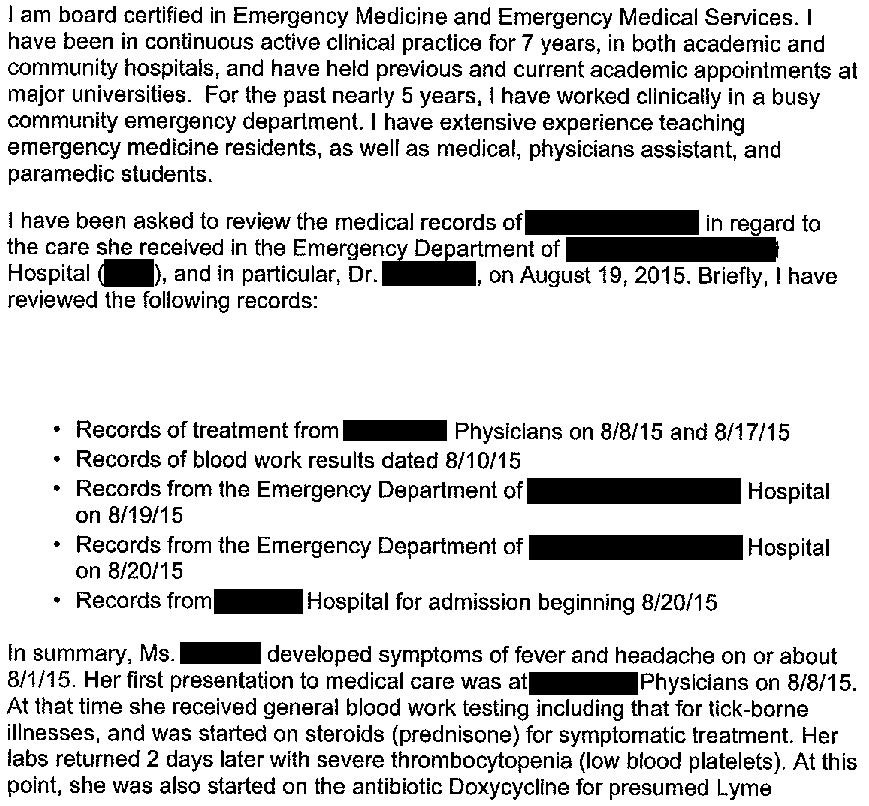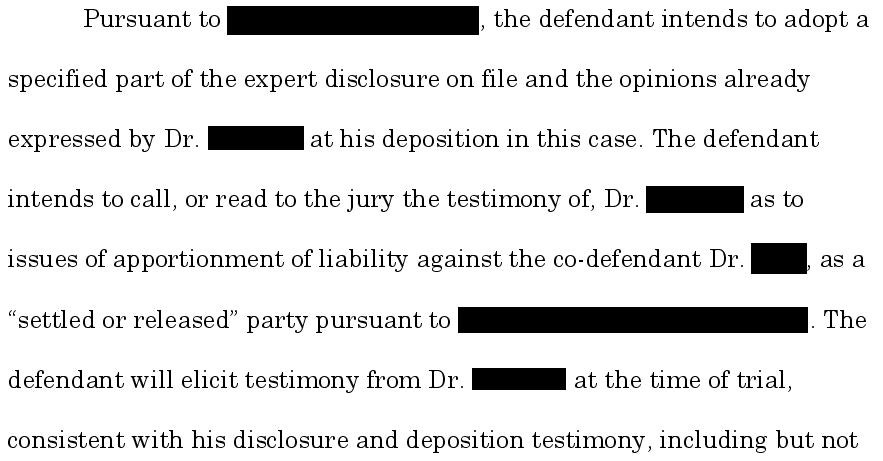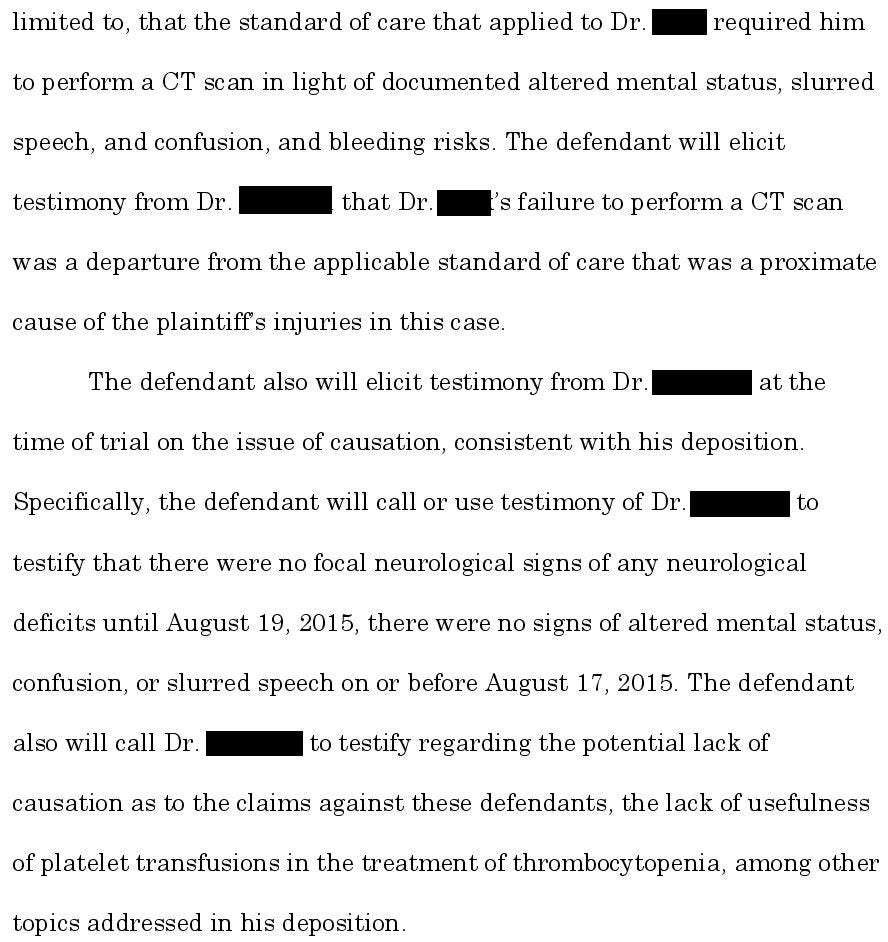A previously healthy 27-year-old woman presented to a rapid access clinic with headache, general malaise, and intermittent fever for one week.
She was seen by an NP.
A CBC and CMP were ordered, but there was no onsite lab so it would take 2 days to get results.
The patient lived in an area with endemic Lyme disease, therefore a Lyme immunoassay screening test was also ordered.
She was prescribed prednisone 20mg BID.
2 days later on August 10, the NP reviewed the lab results.
There were 3 noteworthy findings:
Her platelets were 32,000
Mildly elevated AST and ALT (exact levels not given in court records)
A positive Lyme IgG immunoassay
The NP called the patient, who reported that she did not feel any better.
She was prescribed doxycycline 100mg BID due to concern for Lyme disease.
She documented “her blood work is normal”.
Later that day, the NP’s supervising doctor co-signed her chart from 2 days prior.
The patient traveled to Boston during the next few days, but still was feeling badly.
She returned to the clinic on August 17 with a “horrible” headache.
A different NP saw her, reviewed her chart, and discharged her with pain medication.
2 days later on August 19, she presented to a local ED.
Her chart mentions altered mental status, somnolence, confusion, slurred speech, headache, and intermittent fevers.
A faint petechial rash was documented.
Labs were done, with the only documented finding being thrombocytopenia of 76,000.
No imaging was done given that she was young and did not have any trauma.
The ED physician considered an LP but felt that it was not indicated and that the bleeding risk was too high given her thrombocytopenia.
She was given fluids and Toradol.
Her pain improved from 8/10 to 7/10.
She was discharged.
The next day, her mental status worsened.
She was brought back to the ED and a head CT was ordered.
The interpretation missed the word “hemorrhage”, but is shown below:
She was airlifted to another hospital that had a neurosurgeon.
Her recovery was complicated by seizures, an NSTEMI, both DVT and PE, and pneumonia.
The patient survived but has left hemiparesis.
Join 8700+ doctors and attorneys on the email list.
Free to join, paid options for those seeking to grow their expertise.
A lawsuit was filed against both NPs, their supervising physician, the EM doctor, and the hospital.
The plaintiff’s hired an IM-trained PCP as an expert:
The plaintiffs also hired an EM expert:
The plaintiffs offered to settle with the EM doctor and hospital for $2,000,000.
After negotiating, they reached a confidential settlement.
This left the internist and 2 NP as the only defendants.
They offered to settle with these remaining defendants for $1,000,000 each.
They were initially unable to reach an agreement to settle.
The defense attorneys made a strategic decision to try to shift blame to the EM doctor, now that he had settled.
Therefore, they planned to use the plaintiff’s EM expert opinion as a part of the NP and internist’s defense.
The trial was scheduled for October 2022, but did not occur.
In early December 2022, the judge dismissed the case for “failure to prosecute said action with reasonable diligence”.
I suspect that the lawyers settled the case, and simply did not bother to tell the court.
There is a 4-month grace period in which the plaintiff can apply to re-open the lawsuit.
I will update readers by email if there are any new developments.
MedMalReviewer Analysis:
This is a challenging case in that patients with infectious diseases (including Lyme disease, flu, COVID, among numerous others) can present with headaches and somnolence. They often are so exhausted from being sick that they may seem slightly confused. A patient that seems slightly altered at triage can suddenly carry on normal conversation with the ED doctor a few minutes later. Scenarios like this happen multiple times per day in every ED in America. I have a lot of sympathy for the EM doctor.
I think the key in this case is the cumulative constellation of symptoms. While each individual symptom can easily be explained as sequelae of Lyme disease, the fact that she was slightly confused, had an excruciating headache, and had a neurologic deficit (slurred speech) all support the decision to get a CT scan.When I started reading this case, I thought that it would end with a final diagnosis of meningitis. In fact, the EM doctor was primarily concerned about this as well. Lyme meningitis has been reported and in this case would be a serious concern. In my opinion, it would be higher on the differential than a head bleed. The decision to not perform an LP (and the preceding head CT that is often done prior to the procedure) could be criticized here. A platelet count of <50,000 has been suggested as a safe cutoff, although the available evidence is limited.
While thrombocytopenia is an obvious risk factor for head bleed, I find it somewhat unusual that she bled at a level of 78,000. Most of the literature regarding head bleed risk in thrombocytopenia is related to hematologic cancers and ITP, which may not generalize well to thrombocytopenia due to infectious causes. There are a few case reports of head bleed with Lyme disease, although it appears to be quite rare. It’s possible that she may actually have had neuroborreliosis which predisposed her to a bleed.
This case will probably attract a lot of attention because it involved several NPs. I think there are some valid criticisms, including starting prednisone without a clear indication, failure to recognize the platelet count of 32,000 after the initial NP visit, and failure to refer to the ED after the 2nd NP visit for worsening headache.
Previous Cases:













The first platelet count of 32,000 would have given me pause regarding LP without CT, but I would CT pretty much all heads prior to LP. The prednisone given on first visit could have caused the increased platelet count and steered clinical concern away from spontaneous bleed if one did not know the previous lower count.
Although 78,000 would not worry me as much for risk of bleeding post-LP, I wonder if the ED doc was trying to talk him-/herself into not doing the LP. Unlike hospital records, I don't routinely call for prior urgent care records, but perhaps I will going forward, or at least document they weren't available if after 'business hours'.
Hooray for indiscriminate steroid prescribing. I'm surprised there wasn't a Z-pak in the mix somewhere.
The platelets of 32 should have been addressed, especially in a young woman without family history of coagulopathy. Documenting that as normal was really damning for that first NP. The ER doctor absolutely had rationale to order a CT at his first encounter with her given her neuro symptoms and the duration of her headache. The somnolence should have also been a big red flag in an otherwise healthy 27 year old (IMO). Always easy to see in hindsight though. Thank you so much for these cases, I've shared with multiple colleagues.